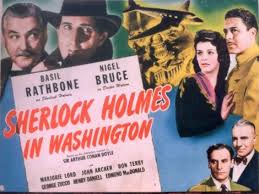
SHERLOCK HOMES IN WASHINGTON
US, 1943, 71 minutes, Black and white.
Basil Rathbone, Nigel Bruce, Marjorie Lord, Henry Daniell, George Zucco, John Archer, Thurston Hall.
Directed by Roy William Neill.
Basil Rathbone and Nigel Bruce first appeared as Sherlock Holmes and John Watson in the 1939 The Adventures of Sherlock Holmes, an upmarket film from 20th Century Fox. They continued their partnership in more than a dozen films, smaller budget, made by Universal Studios.
In the 1940s, three of their films were made as war propaganda, this film, Sherlock Holmes and the Voice of Terror and Sherlock Holmes and the Secret Weapon. It is easy to look at them, even look down at them, from the 21st century vantage point, considering them just propaganda, but this was deemed necessary for the war effort in the 1940s.
A courier takes a government document to the United States and is abducted after the flight. The government, some members unwillingly, ask Sherlock Holmes to go to America to retrieve the document. Of course, Dr Watson goes with him and there is some comedy about American customs, language, chewing gum… with Dr Watson.
Henry Daniell is aboard the plane and responsible for a group of spies. But the main the villain is played by George Zucco (who had been Moriarty in an earlier film). Here he is an antique dealer, posing as an American, but organising a spy network.
Along the way there are some interesting characters, Clarence Muse as the waiter on the train, an elderly lady on the train with mice, the young woman who inadvertently has the document in her possession, on microfilm.
After various manoeuvres in Washington – along with some touches of touristic abuse – Holmes works out who the villain is and where he is, goes in disguise but is unmasked, confronts the villain who has abducted the girl but has not realised that he is not looking for a document but for microfilm concealed in a container of matches.
The film becomes even more patriotic with speeches by Holmes at the end, echoing Winston Churchill about the American – British Alliance, with hopes that after the war human beings will be more humane and moral.
The film was directed by Roy William Neill, who directed most of these films.
1. The popularity of the series of Sherlock Holmes films? Of Holmes and Watson in general? Their appearances in so many different films?
2. The war effort, taking Sherlock Holmes and Dr Watson to Washington, espionage implications? The British government, their concern, the couriers, the deaths of their couriers, the retrieving of the document?
3. Black-and-white photography, American locations, rear-projection of Washington scenes? The American atmosphere, the humour of comment on the differences between Britain and the United States?
4. Basil Rathbone as Sherlock Holmes, the complete impersonation? And the bumbling Nigel Bruce as Dr Watson? Their teamwork? Watson’s naivete? Holmes shrewdness? Logic – and elementary?
5. The voyage on the plane, the spies on board, Grayson and his presence, drunk, trying to mislead the spies? His abduction, his death? Lighting a cigarette Nancy, transferring the microfilm?
6. Holmes’ visit to Grayson’s mother, the touch of pathos? The discovery of questions interest in microfilming?
7. Holmes on the train, the interlude with that letter? The woman with the mice and the fuss? The sinister and the later visit?
8. Nancy, her cigarette, the microfilm in her purse, her fiance, his concern, abduction by the villain?
9. The government officials? Their concern? The background of espionage? Couriers and documents? The American British Alliance?
10. The villain, his background, disguise, the antique shop, Holmes and his disguise, identifying the wood and the furniture? His confrontation with the villain,
the taunting, Holmes and his background with microfilm, the explanations, the concealment, the revelation?
11. The patriotic speeches at the end? The spirit of World War II and propaganda?